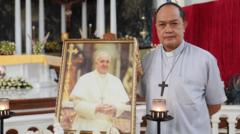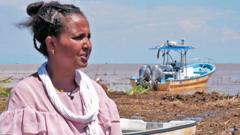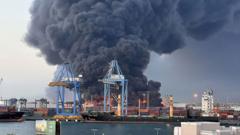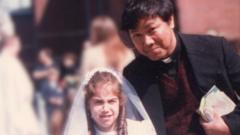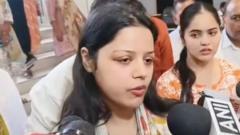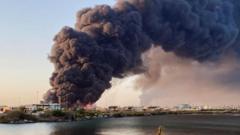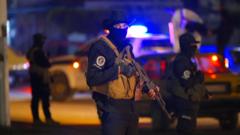In Damascus, a newly opened Identification Centre embarks on the challenging journey to identify victims from Syria's numerous mass graves, reflecting on the human cost of a decade-long conflict. With limited resources and significant uncertainty, the center highlights the emotional toll on families of the lost, raising questions about justice and accountability under the new regime.
Unraveling the Horror: Medics Tasked with Identifying Syria's Mass Grave Victims
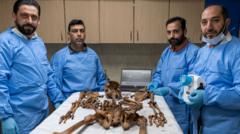
Unraveling the Horror: Medics Tasked with Identifying Syria's Mass Grave Victims
As Syria begins the transition from war to potential reconciliation, medics face the daunting task of identifying remains from mass graves indicative of the brutal civil war.
In the heart of Damascus, Dr. Anas al-Hourani stands amidst remnants of a harrowing past, overseeing operations at the newly inaugurated Syrian Identification Centre. His eyes rest on meticulously numbered tables showcasing femurs—32 human thigh bones meticulously arranged. Each bone potentially belongs to one of the countless Syrians who lost their lives during 13 years of relentless civil war, believed to have been provoked by the regime of the ousted president, Bashar al-Assad, and his father, Hafez, who steadfastly ruled for over 50 years.
Dr. al-Hourani, a forensic odontologist, emphasizes that while identifying remains from a "mixed mass grave" can shed light on the identity of victims—concerning height, sex, age, and employment—accurate identification requires DNA analysis. However, the only lab capable of such testing in Syria faces significant challenges: many facilities were obliterated during the conflict, and ongoing sanctions preclude essential supplies. Moreover, the procedure is expensive at around $250 per test, necessitating roughly 20 tests to piece together one victim's identity. The centre primarily relies on the financial backing of the International Committee of the Red Cross to carry out its tasks.
Though the new Islamist-led government professes its commitment to "transitional justice," many families who have lost loved ones voice their dissatisfaction with the pace and effectiveness of investigations into forced disappearances—a staggering estimate of over 130,000 Syrians. With hundreds of thousands dead and millions displaced, the pathway to closure seems daunting, with Dr. al-Hourani underscoring that it will take years to reveal the identities behind the remains.
Among the stark realities of these investigations are the mixed mass graves scattered around a once-beautiful hilltop outside the city. The BBC team—accompanied by Hussein Alawi al-Manfi, commonly known as Abu Ali—gains insights into the macabre logistics of transporting corpses during the height of the conflict. For over a decade, Abu Ali served as a driver for the Syrian military, moving loads of what he believed to be civilian victims. He described a grim routine of delivering bodies to burial sites, where they would be hastily covered within trenches.
Adding to the narrative of loss is the story of Malak Aoude, who returned to Syria after years in Turkey, only to find her life shadowed by the fate of her two missing sons, who were vanished beneath the oppressive regime. In her desperate search for answers, she revisits the school where Maher was taken, discovering scant documentation that only fuels her anguish for closure amid the ongoing uncertainty of her son's fate, reinforcing the need for accountability in a nation emerging from turmoil.
As Syria faces an uncertain future, the ongoing search for identity and justice for the victims of its civil war raises critical questions about the path towards healing and the necessary accountability for the atrocities committed.

